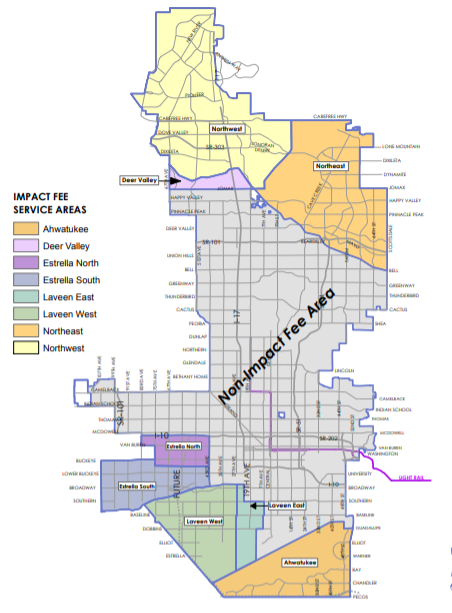Impact fees are widely used by local governments as a tool to help reduce the economic burden of the infrastructure costs that new developments incur due to the expansion of the public service network. These fees are used to fund capital recovery fees for water and sewer facilities, roads, parks, schools and other public services, as well as municipal facilities such as fire, police, and libraries.
 Impact fees are an important tool for financing public infrastructure. Moreover, they can be seen as a tool for growth management that collects development-funding payments as a way to exercise police power.
Impact fees are an important tool for financing public infrastructure. Moreover, they can be seen as a tool for growth management that collects development-funding payments as a way to exercise police power.
Subdividing a jurisdiction into service areas and evaluating infrastructure improvement needs in each area, helps local officials assess the fees necessary to accommodate new growth. Using a tiered fee schedule encourages growth to occur in a denser pattern, thus minimizing sprawling developments as well as facilitating the development of more affordable homes. By more precisely defining service areas for impact fees, communities can ensure that rates remain low for homes in well-served neighborhoods.
The City of Phoenix’s development fee ordinance is considered a best practice for their use of a tiered fee schedule that proportionately addresses growth. To implement this fee format, the City of Phoenix divided their municipality into geographically defined fee service areas. These may include some currently unincorporated areas, in which a set of capital facilities provides reasonably uniform service to development.

Phoenix has 14 designated fees service areas, 8 of which are not required to contribute development impact fees because they have existing public facilities with infrastructure capacity to accommodate growth. The other six areas have limited infrastructure and will require varying levels of infrastructure expansions to accommodate new development.
To determine the amount of the impact fees, each area is evaluated depending on the need for new facilities spurred by new development. Net fees charged on a new single-family home in one of the impact fee areas range from $6,631 in areas with some existing infrastructure to $17,765 in areas requiring substantial new investment.
Prior to assessment of a new or modified development impact fee, the City shall prepare and adopt a Specific Infrastructure Financing Plan (SIFP). The SIFP consists of two sections for each category of capital facility: an Impact Fee Study, and an associated Infrastructure Improvements Plan.
The impact fee study identifies the methodology for calculating the amount of the development impact fee, explains the relationship between the development impact fee and the infrastructure improvements plan, as well as other requirements.
The infrastructure improvement plan estimates the future necessary public services that will be required as a result of new development in each fee service area; forecasts the costs of infrastructure, improvements, real property, financing, and other costs associated with meeting those future needs; forecasts the revenue sources that will be available to fund the necessary public services; and estimates the time required to finance and provide the necessary public services and other requirements.
Development Impact Fees – website Impact Fees Draft Ordinance – website Infrastructure Financing Plan 2015 Downloaded from ResilientWest.org
a project of
Resilient Communities and Watersheds
- Challenges:
- fiscalhealth
- Land Use:
- commercial, multifamily, industrial, mixeduse, singlefamily
- State:
- arizona
- Scale:
- community, site
- Type:
- urban, suburban, rural, amenity

